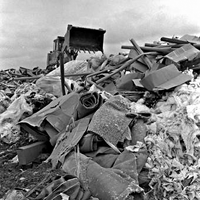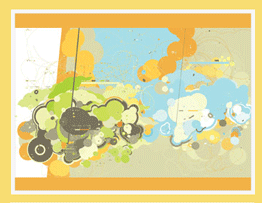Sound Off: Dematerializing Design?
 “Sound Off” is an op/ed post by editors of the Tricycle blog. The opinions may or may not reflect those of the Company.
“Sound Off” is an op/ed post by editors of the Tricycle blog. The opinions may or may not reflect those of the Company.
Tricycle talks a lot about the “dematerialization of design.” As a sustainable design company, one of the things we bring to the table is a bag of digital tools that eliminate unnecessary waste in the design process -- not just literal landfill waste, but also wasted time, money and natural resources. If you want to read more on these tools then click this link... because what I want to talk about here is the why. Or the how. (Or the wow).
Digital tools to dematerialize design? Sounds future-y, even in a world where every day we use credit cards, camera phones and iTunes. And maybe a little scary... what’s going to be lost? Just because the creative process is evolving doesn’t mean we can automatically assume that things are evolving for the better. Sometimes slow is good, sometimes accidents and mistakes and inaccuracies redirect creative thinking so the end product is much better than it might have been otherwise. And isn’t the creative process supposed to be tactile and smelly, and all-around-more-rewarding because pencils are used instead of pixels?
Obviously, daily reality doesn't support any facile belief that tech brings salvation or that a peaceful world community is just around the next bend of what we once called "the information superhighway." But happy accidents can (and do) still happen in a digital design process too, because, after all, digital tools are exactly that -- tools. One thing that is indisputably taking place is that our everyday acceptance of digital tools is cultivating a new set of expectations. Things that were once laughably impossible are now normal: we expect our money, pictures and music to be sharp, accurate and quick. In the carpet industry, where we've spent so much time in recent years, we've used digital tools to erase wasted time and money, to use oil more responsibly, to conserve energy and water, to show that thousands of pounds of waste that would have gone to landfill do not have to be manufactured in the first place.
One thing that is indisputably taking place is that our everyday acceptance of digital tools is cultivating a new set of expectations. Things that were once laughably impossible are now normal: we expect our money, pictures and music to be sharp, accurate and quick. In the carpet industry, where we've spent so much time in recent years, we've used digital tools to erase wasted time and money, to use oil more responsibly, to conserve energy and water, to show that thousands of pounds of waste that would have gone to landfill do not have to be manufactured in the first place.
It's beautiful to watch benefits such as these move from celebrated “best practices” to becoming industry standards. Nothing more than the norm.
Has video killed the radio star? Maybe. But are other, new, great things coming about as a result? After all (quite ironically) that song's video was the first video ever played on MTV, at the moment of the channel's debut in 1981; 25 years later the evolution of music is still revising what it means to be a radio star via sites like garageband.com. Even talk radio has had a makeover: move over, Rush Limbaugh, to make way for Karl Pilkington.  For a parallel in design, witness Joshua Davis, a Pratt Institute trained illustrator who uses Illustrator® to create design elements such as trees, leaves, flowers... then brings an added layer to his work by coding programs to randomly generate artwork using the elements, based on mathematical algorithms.
For a parallel in design, witness Joshua Davis, a Pratt Institute trained illustrator who uses Illustrator® to create design elements such as trees, leaves, flowers... then brings an added layer to his work by coding programs to randomly generate artwork using the elements, based on mathematical algorithms.
The design of buildings, interiors, and products are by their nature focused on the material world. With digital design processes, the material world has expanded to include a tech-enabled immaterial, and new avenues for imagination are opening up because designers are finding themselves with more time and ability to explore creative options, as well as new types of creativity. Part of what has always made design interesting to me is its ability to tap the transcendent through (and only through) the concrete. This "immaterial" world is not the same thing as the transcendent, but perhaps immaterial tools can be used alongside material tools to bring us a bit closer.
And for those who resist? Who would favor an Agrarian-style return to pen and paper? Of course there's good to be found in those impulses, too; after all, revolution against design’s evolution is... well, part of design’s evolution.
Caleb Ludwick is Communications Director at Tricycle, Inc. He thinks it's hilarious that Vanderbilt has posted the Agrarians' work in a Virtual Reading Room (click above).
No comments:
Post a Comment